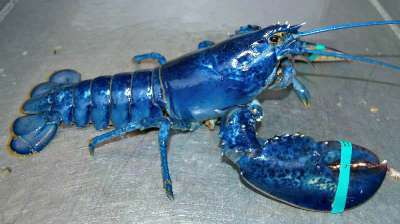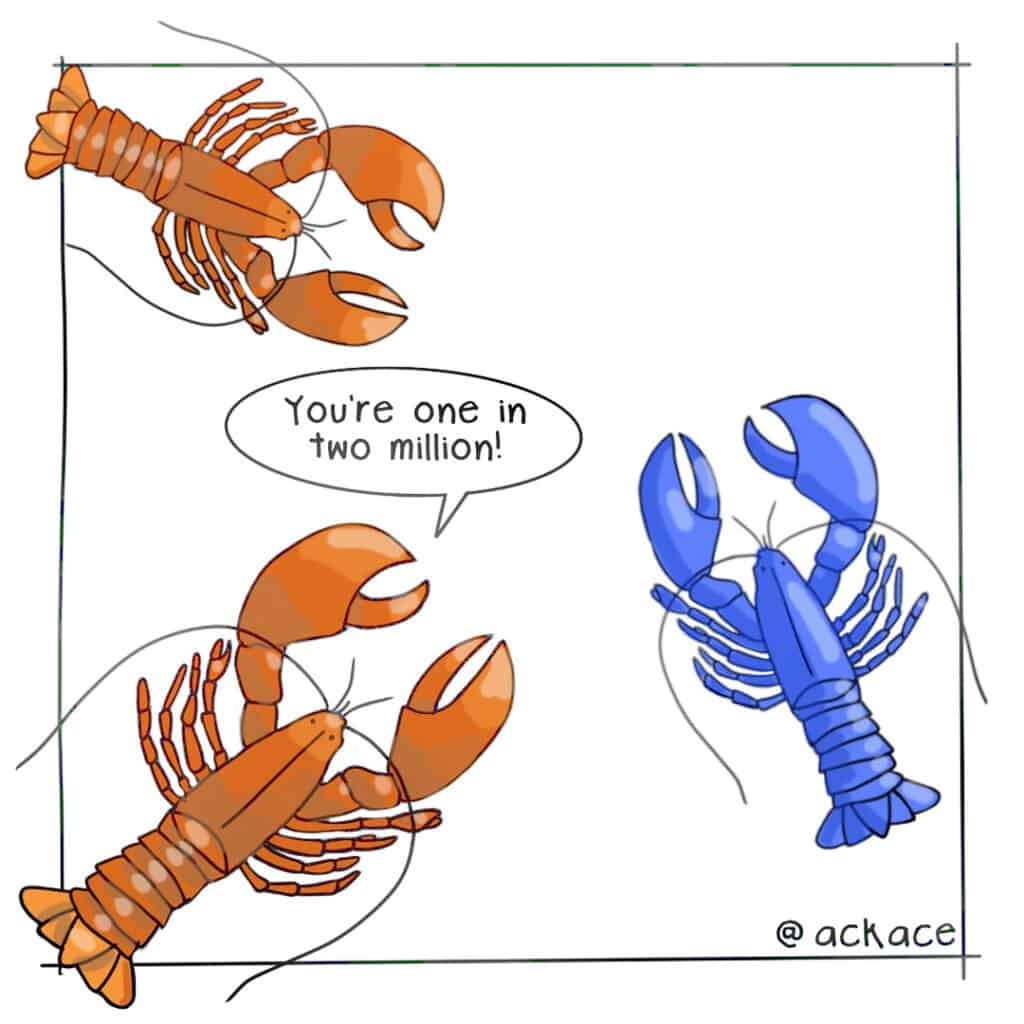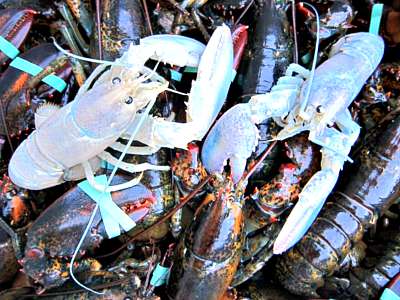A quick Instagram search for #lobsters brings up an army of bright red crustaceans, straight out of a children’s guide to ‘Under the Sea’. That’s not all though. You’ll also find plenty of snaps of unfortunate beachgoers who, after a few too many hours sun-seeking, have found themselves as “red as a lobster”.
Unsurprisingly, then, most modern cartoons and illustrations stick to the iconic ‘lobster red’ when depicting these special sea creatures. For the Chinese, the color red symbolizes good luck; it’s no wonder lobster is a popular dish at Chinese New Year celebrations. Red also represents passion, romance and love. So don’t forget to order a romantic lobster dinner for Valentine’s Day, your anniversary, or a casual dinner date! Hint Hint.

Are Lobsters Really Red in Color?
In the face of all of the unquestionably crimson lobster imagery, it might then seem strange to ask: are lobsters really red?
Some landlocked Americans believe that a wild, live lobster is red in color. At LobsterAnywhere a few customers have questioned whether the lobster delivered to their home was safe to cook because it was not red. However, lobster-lovers are beginning to learn more about Maine’s most famous export. All thanks for the new wave of cooking channels and popular reality shows such as the Discovery Channel’s ‘Lobstermen’. For a closer look at lobsters in popular culture check out our blog post about all the fun lobster movies.
What Color are Lobsters?
Lobsters come in many different colors because of the pigment chromatophores in their shells. When they are cooked, all the pigments are masked except for astaxanthin, the red background pigment. The red pigment is the most stable component of the coloring in a lobster. The greens and browns which darken the shell in a live lobster are destroyed by the cooking process.

When they are cooked, all the pigments are masked except for astaxanthin, the red background pigment. The red pigment is the most stable component of the coloring in a lobster. The greens and browns which darken the shell in a live lobster are destroyed by the cooking process.
Fishermen have been known to bring in blue, yellow, red and spotted live lobsters. Usually, when lobsters are hard-shelled, their shells are a darker color. Also, when you cook hard-shell lobsters, their shells will turn a brick red color and sometimes black. Whereas soft-shelled lobsters, when cooked, are a bright red color.
As you will see, the traditional Maine lobster comes in a surprisingly wide range of colors. See the New England Aquarium’s collection of lobsters in rare colors.
Kinds of Lobster
Before we get on to the specifics of coloring, we should probably establish: what exactly is a lobster? The term ‘lobster’ itself is actually a fairly wide term, encompassing the entire Nephropidae family. The most common lobsters that people think about are the American and European lobsters. However, they are found in all oceans. The term also includes several varieties of scampi, from oceans in both the northern and southern hemispheres.
So, back to color! We all know that cooked Cape Lobster
This lobster, just recently included in the Nephropidae family, if sound in the seas of South Africa. Specimens have been found in colors yellow, brown and olive. This is also the only lobster that can be found red whilst alive. In general, these lobsters are a greenish-brown color when alive. Of course, there have been some rare colors surface from the ocean depths and fall into a cooking post over the years. European lobsters are generally blue, with a yellow ventral surface (the belly). Where it gets really interesting, though, is the story of the Maine lobster. Also known as the American lobster, or the ‘true’ lobster, which is the largest lobster variety by far. Scientists believe darker colored lobsters are likely to have evolved through natural selection in order to avoid predators. This makes it is unsurprising that these are the largest variety in the wild. You’ll also see darker colored lobsters are found in the deeper waters. Whereas the lighter colored lobsters are closer to shore. The rays of the sun will lighten the lobster’s shell. The shells of all lobsters have a mix of red, blue and yellow pigments, or chromatophores. The exact mix of these varies as much in individual lobsters as hair and skin color do in us humans. Lobsters’ shells thicken not long after molting. The thicker, ‘hard-shelled’ lobsters tend to be darker in color than ‘soft shell’ lobsters that have recently shed their exoskeletons. Scientists say that lobsters have probably always been cropping up in unusual colors here and there. In today’s world, however, where everyone has a camera (and an Instagram account) the odd ones get much more attention. So, what is really behind these multi-colored oddities? Don’t be fooled, lobsters are not red! One of Norman Rockwell’s most popular covers debuted in the Saturday Evening Post on April’s Fools Day, 1945. It has over 50 intentional inaccuracies. The blue lobster in the illustration is not one of them. Can you find the other “mistakes” and contradictions below? The odds of catching a blue lobster are 1-in-2 million. While yellow and orange-and-black calico lobsters come in at 1-in-30 million. Split-colored varieties have been pegged at 1-in-50 million. White – the rarest of all – at 1-in-100 million. Science tells us that blue lobsters are not just uncommon, but are in fact mutants. This is the result of a genetic mutation that causes the blue color. Blue lobsters are, in fact, the result of a single mutation of one piece of the SNA of American lobsters. This mutation causes an overproduction of a particular protein. This results in the bright blue pigment, rather than the typical mix of pigments that give the typical greenish-brown. In the wild, approximately one one in 2 million lobsters are blue. It isn’t clear whether all of these are descendants of the first mutant blue lobster, or if it is independently occurring. Just this August a Swan Island stern man hit the lottery when he trapped a rare, two-pound blue lobster. He plans to donate this special crustacean to a local aquarium. Yellow Maine lobsters, although not really albinos, are truly rare; roughly one in 30,000,000 wild lobsters are yellow. As with the bright blue lobsters, the color is the result of a mutation in the proteins that bond with the shell pigments. At least five yellow lobsters have been caught in the last ten years. One of which made it all the way to Hawaii from Canada (in a shipment, he did not swim!) before being discovered. Albino lobsters do exist, and one was caught in 2006 in Massachusetts. These lobsters are true albinos. They entirely lack pigmentation throughout their bodies, which is thought to be a significant disadvantage in the wild. It is therefore not surprising that experts estimate that only one in 100 million adult lobsters are albino. Calico lobsters, also known as ‘orange lobsters‘, are also quite rare. They rank alongside the yellow lobster at roughly one in 30 million. They are notable in the unique pattern of mottled orange and black on their shells. Several lobsters have been caught that had a different coloration pattern on their right and left halves. These lobsters are true oddities. In the last 50 years only three of these special creatures have been spotted. The odds of finding another? One in 50 million. We call these ‘chimeras’ because they are not mutants, as such, but something altogether stranger. They are in fact a conjoined twin. The result of two embryos developing in the same egg, but fusing into one individual animal. This means that the left half is the brother or sister of the right half. Odder still, sometimes the right half is a different sex than the left half. That must really be confusing, especially for other lobsters! Now, logic dictates that chimerical lobsters should be a lot more common than we might expect. If both twins are the same color, how would we know? Not many people go around comparing the DNA of the right and left claws of random sea creatures. At least, no one I know! Finally, the red lobster! Not exclusively the window trophy of seafood restaurants, truly red lobsters really do exist in the wild. They’re not as common as our visual lobster culture would have you expect. Around one in ten million lobsters are naturally red before cooking. Apparently these lobsters are not mutants. They are the same as blue and yellow lobsters, but they just have more red pigment. This manifests with red exoskeletons. As you might expect, they stay red once cooked. By now we’ve seen that, if live lobsters are red, then red comes in 50 shades of yellow, blue, green, brown. But what we are all most concerned with is the lobster on our plate. Are all cooked lobsters red? Mostly yes. As lobsters are cooked they maintain the slight differences in color that they had whilst alive. So to answer: Yes, cooked lobsters will be various shades of red. Scientists at the University of Manchester have identified the red pigment as being the chemical ‘astaxantin’. A carotenoid pigment is the same red color as a cooked lobster. When the creature is cold, this chemical is overridden by a blue protein, ‘crustacyanin’. However, when the lobster is cooked, the pigment bonds that cause the greenish-brown color of the cold lobster are broken down. The end result? Only the carotenoid, or ‘red’ pigment, is left. This means, though, that we are left in a philosophical quandary. If all lobsters (save the super rare albino) have this red pigment, are all lobsters really red, even before they’re cooked? Maybe our cartoons are not so inaccurate after all! Not in Maine? You can order a live Maine lobster shipped overnight to your front door. Do you want to see some live colored lobsters in person? Take a road trip to scenic West Boothbay Harbor, and visit the Maine State Aquarium. Don’t forget to grab a lobster_rollMaine Lobster

The Blue Lobster



Yellow Lobsters

Albino Lobsters
Calico Lobsters

Chimerical Lobsters
Red Lobsters
Into the Pot!
See Rare Colored Live Lobsters
Maine State Aquarium
194 McKown Point Rd,
West Boothby Habor, ME 04575
(207) 633-9559